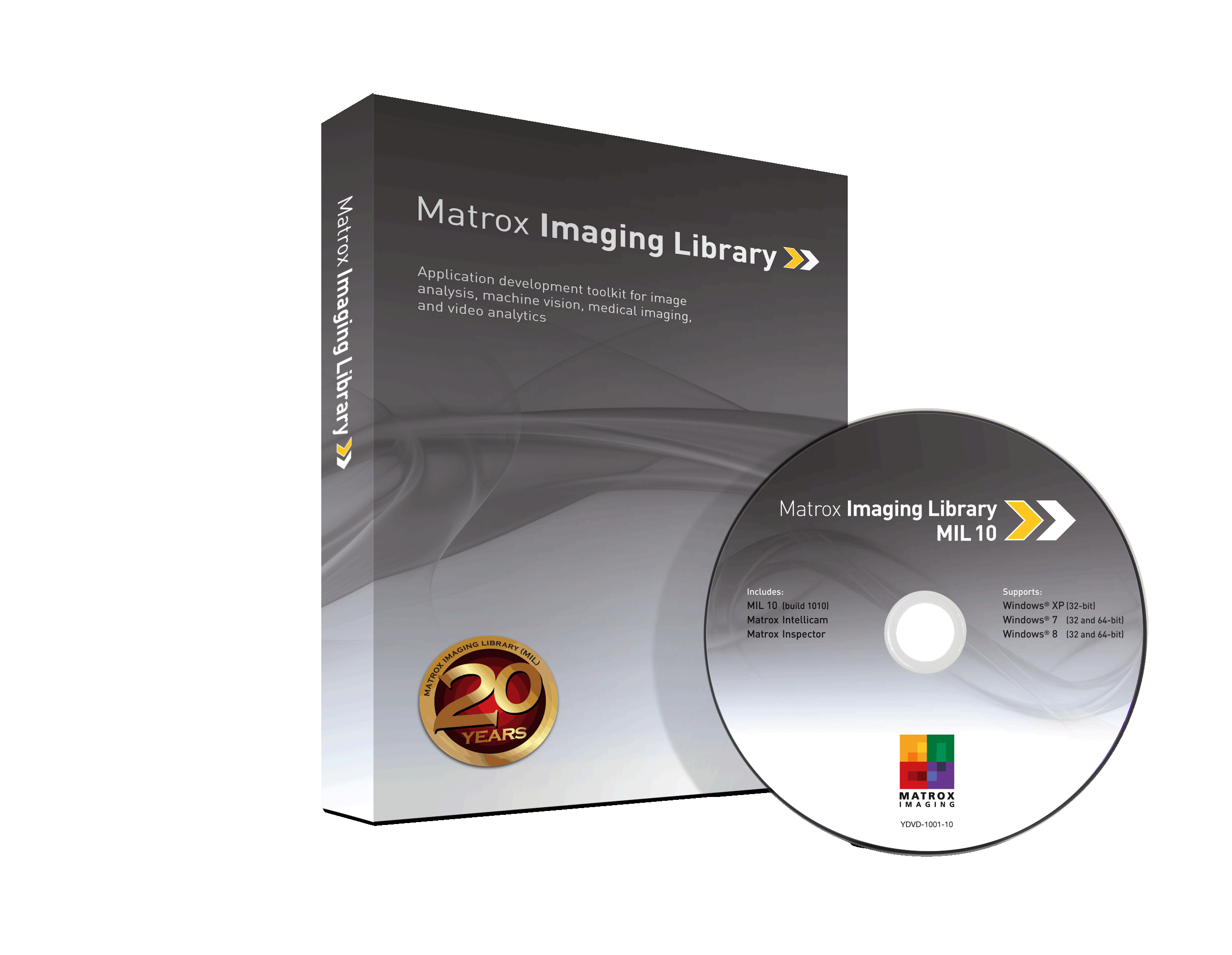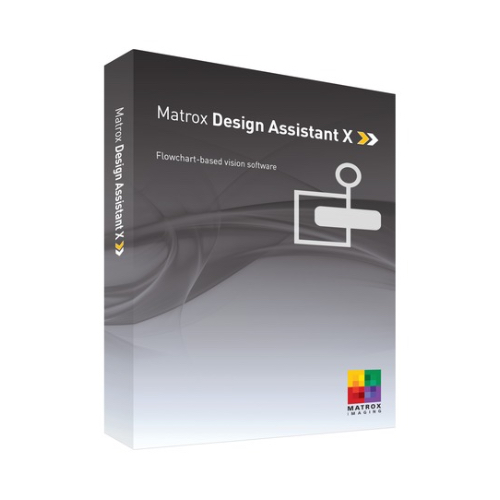Description
Industrial imaging tools
Matrox Imaging Library (MIL)1 is a comprehensive collection of software tools for developing machine vision, image analysis and medical imaging applications. MIL includes tools for every step in the process: from application feasibility, to prototyping, through to development and ultimately deployment.
The toolkit features interactive software and programming functions for image capture, processing, analysis, annotation, display and archiving. These tools are designed to enhance productivity, thereby reducing the time and effort required to bring your solution to market.
Image capture, processing and analysis operations have the accuracy and robustness needed to tackle the most demanding applications. These operations are also carefully optimized for speed to address the severe time constraints encountered in many applications.
Benefits
| Solve applications rather than develop underlying tools by leveraging a toolkit with a 20-year history of reliable performance
|
| Tackle applications with utmost confidence using field-proven tools for analyzing, locating, measuring, reading and verifying
|
| Harness the full power of today’s hardware through optimizations exploiting SIMD, multi-core CPU, multi-CPU, GPU2 and FPGA technologies
|
| Easily support platforms ranging from smart cameras to HPC clusters via a single consistent and intuitive API
|
| Obtain live images from the interface of choice through support for analog, Camera Link®, Camera Link HS, CoaXpress®, DVI-D, GigE Vision®, IEEE 1394 IIDC, SDI, and USB3 Vision™ 2,3 transmission formats
|
| Maintain flexibility and choice by way of 32-bit Windows® XP, 32/64-bit Windows 7 and 8.1, 32/64-bit Linux®, and RTX643 (RTOS) support
|
| Make the best use of available programming know-how with support for C, C++, C#, CPyhton3 and Visual Basic® languages
|
| Increase productivity further and reduce development costs by receiving training and assistance from our team of imaging experts
|
About MIL development
First released in 1993, MIL has evolved to keep pace with and foresee new industry requirements. It was conceived with an easy-to-use coherent application programming interface (API) that has stood the test of time. MIL pioneered the concept of hardware independence with the same API for different image acquisition and processing platforms. A team of highly-skilled and dedicated computer scientists, mathematicians, software engineers and physicists continue to maintain and enhance MIL.
MIL is developed using industry recognized best practices including peer review, user involvement and daily builds. Users are asked to evaluate and report on new tools and enhancements, which strengthens and validates releases. Ongoing MIL development is integrated and tested as a whole on a daily basis.
About MIL SQA
In addition to the thorough manual testing performed prior to each release, MIL continuously undergoes automated testing during the course of its development. The automated validation suite, consisting of both systematic and random tests, verifies the accuracy, precision, robustness, and speed of image processing and analysis operations. Results, where applicable, are compared against those of previous releases to ensure that performance remains consistent. The automated validation suite runs continuously on hundreds of systems simultaneously, rapidly providing wide-ranging test coverage. The systematic tests are performed on a large database of images representing a broad sample of real-world applications.
 |
 |
|
| Manual testing performed prior to each release. | Partial setup of continuous automated testing. |
Field-proven tools
Central to MIL are tools for calibrating, enhancing and transforming images, locating objects, extracting and measuring features, reading character strings, and decoding and verifying identification marks. These tools are carefully developed to provide outstanding performance and reliability, and can be used within a single computer system or distributed across several computer systems.
|
|
Prototype
Interactive tools
MIL comes with a set of interactive tools to help assess application feasibility, create a prototype and analyze application performance. These interactive tools also further enhance the productivity of application developers.
Matrox Inspector
Bundled with MIL is Matrox Inspector, an integrated imaging environment for 32-bit Windows®. Matrox Inspector provides an easy-to-use interface with point-and-click access to MIL image capture, processing, analysis and archiving operations.
In addition to displaying images, Matrox Inspector presents processing and analysis results as tables and/or graphs, including trend and distribution, which are useful for tuning operation settings. The application also gives users the ability to benchmark operations for accuracy and repeatability. In addition to making annotations, users can draw into images to perform measurements as well as touch-up and manually segment images.
Additional processing and analysis utilities
MIL includes a collection of interactive Windows-based utilities for each key image processing and analysis tool. Intended for configuration and experimentation, each tool supports live image capture and processing as well as file I/O for individual or sequences of images. Tooltips over dialog controls provide a convenient cross-reference to actual MIL function calls.
MIL includes interactive utilities for configuration and experimentation.
Matrox Profiler
Matrox Profiler is a Windows-based utility to post-analyse the execution of a multi-threaded application for performance bottlenecks and synchronization issues. It presents the function calls made over time per application thread on a navigable timeline. Matrox Profiler allows the searching for, and selecting of, specific function calls to see their parameters and execution times. It computes statistics on execution times and presents these on a per function basis. Matrox Profiler tracks not only MIL functions but also suitably tagged user functions. Function tracing can be disabled altogether to safeguard the inner working of a deployed application.
Matrox Profiler application analysis performance tool.
Develop
Complete application development environment
In addition to image processing, analysis and archiving tools, MIL includes image capture, annotation and display functions, which form a cohesive API. The API and accompanying utilities are recognized, by the large installed base of users, as being helpful to facilitate and accelerate application development.
Portable API
The MIL C API is not only intuitive and straightforward to use but it is also portable. It allows applications to be easily moved from one supported video interface or operating system to another, which provides platform flexibility and protects the original development investment.
.NET development
Included in MIL is a low-overhead API layer for developing Windows® applications within the .NET Framework using managed Visual Basic® and Visual C#® code.
JIT compilation and scripting3
MIL supports C# and Visual Basic just-in-time (JIT) compilation and CPython scripting, facilitating experimentation and prototyping. Such code can even be executed from within a MIL-based application, providing a simpler way to tailor an already deployed application.
Simplified platform management
With MIL, a developer does not require an in-depth knowledge of the underlying platform. MIL is designed to deal with the specifics of each platform and provide simplified management (e.g., hardware detection, initialization and buffer copy). MIL gives developers direct access to certain platform resources such as the physical address of a buffer. MIL also includes debugging services (i.e., function parameter checking, tracing and error reporting), as well as configuration and diagnostic tools.
MIL configuration and diagnostic tool.
Designed for multi-tasking
MIL supports multi-processing and multi-tasking programming models: multiple MIL applications not sharing MIL data or a single MIL application with multiple threads sharing MIL data. It provides mechanisms to access shared MIL data and ensure that multiple threads using the same MIL resources do not interfere with each other. MIL also offers platform-independent thread management for enhancing application portability.
Supported data formats
MIL can manipulate data, such as monochrome images, stored in 1, 8, 16 and 32-bit integers, as well as 32-bit floating point formats. MIL can also handle color images stored in packed or planar RGB/YUV formats. Commands for efficiently converting between data types are included.
Saving and loading images
MIL supports the saving and loading of individual images or sequence of images to/from disk. Supported file formats are AVI (Audio Video Interleave), BMP (bitmap), JPG (JPEG), JP2 (JPEG2000), MP4 (MPEG-4 Part 14), native (MIM), PNG and TIF (TIFF), as well as a raw format.
Industrial and robot communication3
MIL lets applications interact directly with automation controllers using the EtherNet/IP™, MODBUS® and PROFINET industrial communication protocols. It also supports native communication with robot controllers from ABB, DENSO, EPSON, FANUC, KUKA and Stäubli.
Matrox Intellicam frame grabber and camera configuration tool.
Software architecture
MIL provides a comprehensive set of application programming interfaces, imaging tools and hardware support
Supported Environments
For Windows®
- 32-bit Windows XP with SP3 / 7 with SP1 / 8.1
- 64-bit Windows 7 with SP1 / 8.1i
- Windows Embedded Standard 7 (with Matrox 4Sight GP and Matrox 4Sight GPm)
- Visual Studio® 2008 with SP1 / 2010 with SP1 / 2012 with Update 4 / 2013 (unmanaged C++, C# and Basic)
- CPython 2.7 and 3.4
For RTX64
- RTX64 2014 with SP2 and Update 2 (and 64-bit Windows 7 with SP1)
- Visual Studio 2013 with Update 5 / 2015 with Update 4 (unmanaged C++)
For Linux®
- 32/64-bit Ubuntu 14.04.3 LTS
- 64-bit Red Hat Enterprise Linux 7.1 and CentOS 7 (build 1503)
- 64-bit SUSE Linux Enterprise 12
- GNU Compiler Collection and Python (from particular Linux distribution)
i. Partially tested with Windows® Server 2008 R2 and 2012.
MIL for real-time Windows3
MIL is available to run natively in IntervalZero’s RTX64 real-time operating system platform for Windows. RTX64 runs on its own dedicated CPU core(s) alongside Windows to provide a more tightly bound deterministic environment.  Under this architecture, a developer partitions a MIL-based application to run on RTX64 and Windows. Response-critical parts are performed in RTX64. These include image capture, processing and analysis, and more significantly, output activation and real-time communication. Less response-critical aspects such as image display and file I/O continue to be conducted in Windows.
Under this architecture, a developer partitions a MIL-based application to run on RTX64 and Windows. Response-critical parts are performed in RTX64. These include image capture, processing and analysis, and more significantly, output activation and real-time communication. Less response-critical aspects such as image display and file I/O continue to be conducted in Windows.
Development for RTX64 is done in C/C++ using Visual Studio and a subset of the Windows API. MIL for RTX64 supports image capture using GigE Vision® and supported Matrox frame grabbers. Distributed MIL’s shared memory protocol is available to efficiently handle communication and data exchange, including images, between a MIL process running on RTX64 and one running on Windows. The required MIL licenses are shared between Windows and RTX64.

















